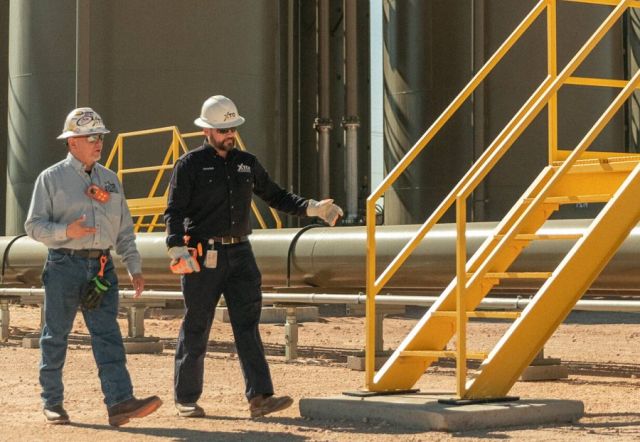
Exxon Mobil facilities at Poker Lake, New Mexico. (Source: Exxon Mobil)
The Permian Basin may inspire awe with its prolific oil and gas production, but the real work happens in the shale play’s basement.
Beneath the Permian is a sprawl of thousands of feet of lateral wells that E&Ps are constantly working to improve—and lengthen. In 2010, the average lateral length of a Permian lateral was 3,870 ft, according to the U.S. Energy Information Administration. By 2022, laterals were more than 2.5x longer, averaging 10,064 ft.
In 2019, Surge Energy boasted a 17,935-ft (3.4-mile) well, although Rystad Energy noted in 2022 that, over time, productivity in longer laterals generally became comparable to shorter horizontal wells. Diamondback Energy President and CFO Kaes Van't Hof, once skeptical of drilling even longer wells, recently conceded that 4-mile wells will likely be needed in secondary zones to compete with the best of the Permian.
And as technology evolves and techniques improve, some operators have set their sights on routinely pushing past the 12,500-ft to 15,000-ft mark to maximize productivity and reduce costs.
The most recent E&P to swing for the fences: Exxon Mobil, with a 20,000-ft well in Poker Lake, New Mexico.
“Historical trends indicate that the average lateral length of horizontal land wells continues to increase with time. The average lateral length in the Permian in [third quarter 2022] was 10,000 ft, with the average approaching 11,000 ft today,” William Dacus, Permian wells manager for Exxon Mobil told Hart Energy. “As the industry continues to optimize completion and production techniques, it will strive to drill longer wells to reduce cost per lateral foot.”
Responsible for 20 of the longest wells drilled globally, Exxon is no stranger to lateral wells. But the crown jewel of operations prowess is the Poker Lake well.
Poker Lake, drilled by Nabors’ X12 rig, is the longest lateral in the Permian at more than 20,000 ft.
To drill the well, Exxon had to take lessons from previously drilled wells, taking into consideration which tools would work best and which new technologies to deploy.
“We leveraged these learnings and our engineering and operations expertise as we planned and executed our 4-mile laterals in Poker Lake,” Dacus said. “Key rig and equipment selection considerations were related to operating torque limiters and fluids system. Another important consideration is choosing a well design and directional tools that deliver the most favorable wellbore for casing run and completions.”
Rotary steerable tools were used in the intermediate and production sections to minimize dogleg severity. Additionally, innovations such as larger outer diameter (OD) casing, extended wireline spools and a hydraulic control unit with tapered work string were pivotal in optimizing completion and drill-out operations.
Each well was drilled in less than 30 days, with frac operations taking about 11 days per well and frac plug drill out averaging 12 days per well. Even with the success of the Poker Lake project, Exxon was met with challenges. A well exceeding three miles in length will inherently have issues, Dacus said. Problems arose with the well’s high operating torque and weight transfer past three miles. Frac plug drill out also presented a challenge.
“Running an additional mile of production casing in the lateral was a concern. However, emphasizing wellbore quality proved to be beneficial for both the casing run and drill out of frac plugs. Different wireline units and tapered work strings were utilized when compared to shorter lateral wells,” Dacus said. “Production casing was partially air-filled during deployment to allow the casing string to be floated while running to reduce the effective weight.”
Poker Lake proved to be a learning experience for Exxon, driving home the importance of wellbore quality and the need for a diversified and tailored approach to tackling longer laterals. Looking ahead, plans are already in motion for rig upgrades and further optimization efforts, ensuring Exxon Mobil remains at the forefront of lateral well drilling technology.
“Rig upgrades have been performed to address learning from the initial drilling campaign,” Dacus said. “Plans to assess drill out work string design, frac plug selection and frac cluster placement for future campaign is ongoing. Further costs and performance optimizations will continue as we expand our 4-mile lateral capabilities.”
While Exxon is one of the few Permian E&Ps to drill to the 4-mile mark, it’s only a matter of time before other operators look to replicate the company’s success.
Recommended Reading
Kissler: Gas Producers Should Still Hedge on Price
2025-03-27 - Recent price jumps and rising demand don’t negate the need to protect against future drops.
Not Sweating DeepSeek: Exxon, Chevron Plow Ahead on Data Center Power
2025-02-02 - The launch of the energy-efficient DeepSeek chatbot roiled tech and power markets in late January. But supermajors Exxon Mobil and Chevron continue to field intense demand for data-center power supply, driven by AI technology customers.
The Private Equity Puzzle: Rebuilding Portfolios After M&A Craze
2025-01-28 - In the Haynesville, Delaware and Utica, Post Oak Energy Capital is supporting companies determined to make a profitable footprint.
BlackRock CEO: US Headed for More Inflation in Short Term
2025-03-11 - AI is likely to cause a period of deflation, Larry Fink, founder and CEO of the investment giant BlackRock, said at CERAWeek.
Confirmed: Liberty Energy’s Chris Wright is 17th US Energy Secretary
2025-02-03 - Liberty Energy Founder Chris Wright, who was confirmed with bipartisan support on Feb. 3, aims to accelerate all forms of energy sources out of regulatory gridlock.
Comments
Add new comment
This conversation is moderated according to Hart Energy community rules. Please read the rules before joining the discussion. If you’re experiencing any technical problems, please contact our customer care team.





